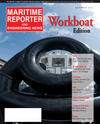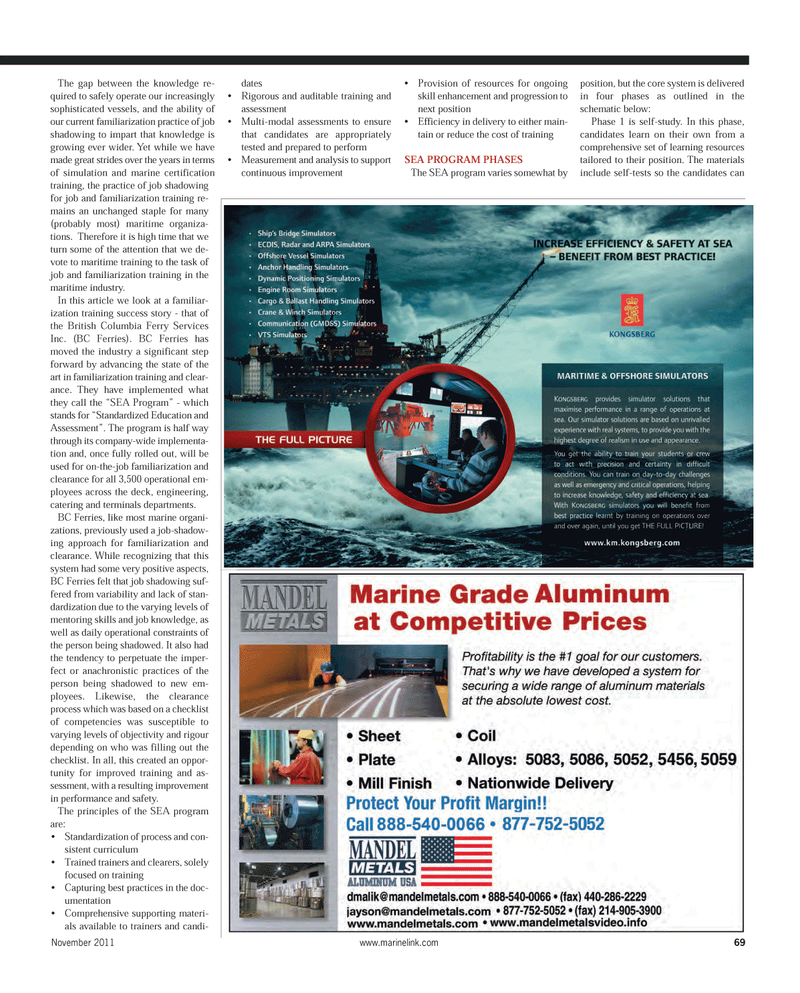
Page 69: of Maritime Reporter Magazine (November 2011)
Feature: Workboat Annual
Read this page in Pdf, Flash or Html5 edition of November 2011 Maritime Reporter Magazine
November 2011www.marinelink.com 69The gap between the knowledge re- quired to safely operate our increasinglysophisticated vessels, and the ability of our current familiarization practice of job shadowing to impart that knowledge is growing ever wider. Yet while we have made great strides over the years in terms of simulation and marine certification training, the practice of job shadowing for job and familiarization training re- mains an unchanged staple for many (probably most) maritime organiza- tions. Therefore it is high time that we turn some of the attention that we de-vote to maritime training to the task of job and familiarization training in the maritime industry. In this article we look at a familiar- ization training success story - that ofthe British Columbia Ferry ServicesInc. (BC Ferries). BC Ferries hasmoved the industry a significant step forward by advancing the state of the art in familiarization training and clear- ance. They have implemented what they call the ?SEA Program? - which stands for ?Standardized Education andAssessment?. The program is half way through its company-wide implementa- tion and, once fully rolled out, will beused for on-the-job familiarization and clearance for all 3,500 operational em-ployees across the deck, engineering, catering and terminals departments.BC Ferries, like most marine organi- zations, previously used a job-shadow- ing approach for familiarization and clearance. While recognizing that this system had some very positive aspects, BC Ferries felt that job shadowing suf- fered from variability and lack of stan- dardization due to the varying levels of mentoring skills and job knowledge, as well as daily operational constraints ofthe person being shadowed. It also had the tendency to perpetuate the imper- fect or anachronistic practices of theperson being shadowed to new em- ployees. Likewise, the clearance process which was based on a checklist of competencies was susceptible to varying levels of objectivity and rigour depending on who was filling out the checklist. In all, this created an oppor- tunity for improved training and as- sessment, with a resulting improvement in performance and safety. The principles of the SEA programare:Standardization of process and con- sistent curriculumTrained trainers and clearers, solely focused on trainingCapturing best practices in the doc- umentationComprehensive supporting materi- als available to trainers and candi- datesRigorous and auditable training and assessmentMulti-modal assessments to ensure that candidates are appropriatelytested and prepared to performMeasurement and analysis to support continuous improvement Provision of resources for ongoing skill enhancement and progression tonext position Efficiency in delivery to either main- tain or reduce the cost of trainingSEA PROGRAM PHASES The SEA program varies somewhat by position, but the core system is delivered in four phases as outlined in theschematic below: Phase 1 is self-study. In this phase, candidates learn on their own from a comprehensive set of learning resources tailored to their position. The materials include self-tests so the candidates canMR Nov.11 # 9 (65-73):MR Template 11/2/2011 3:24 PM Page 69

 68
68

 70
70
